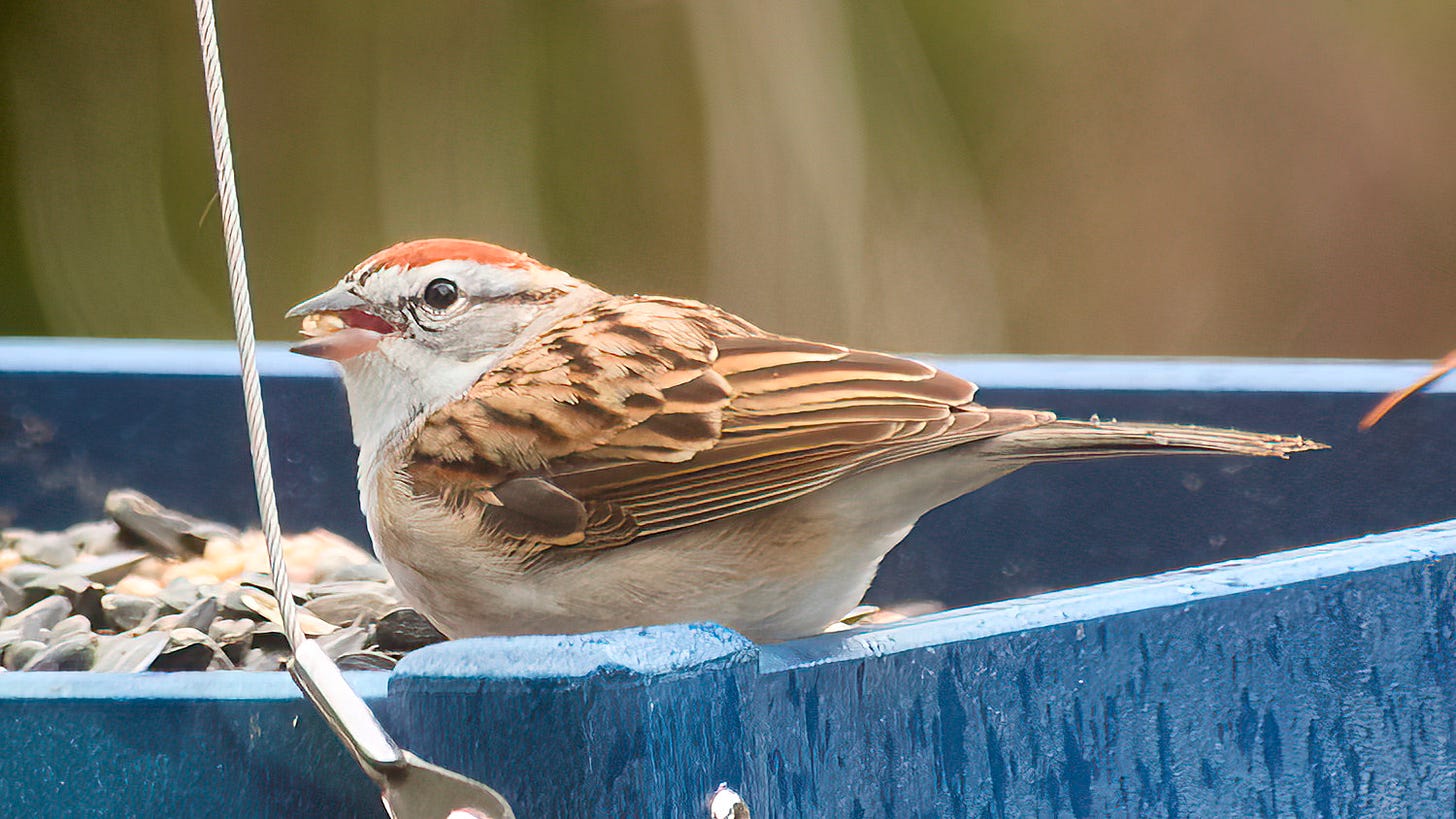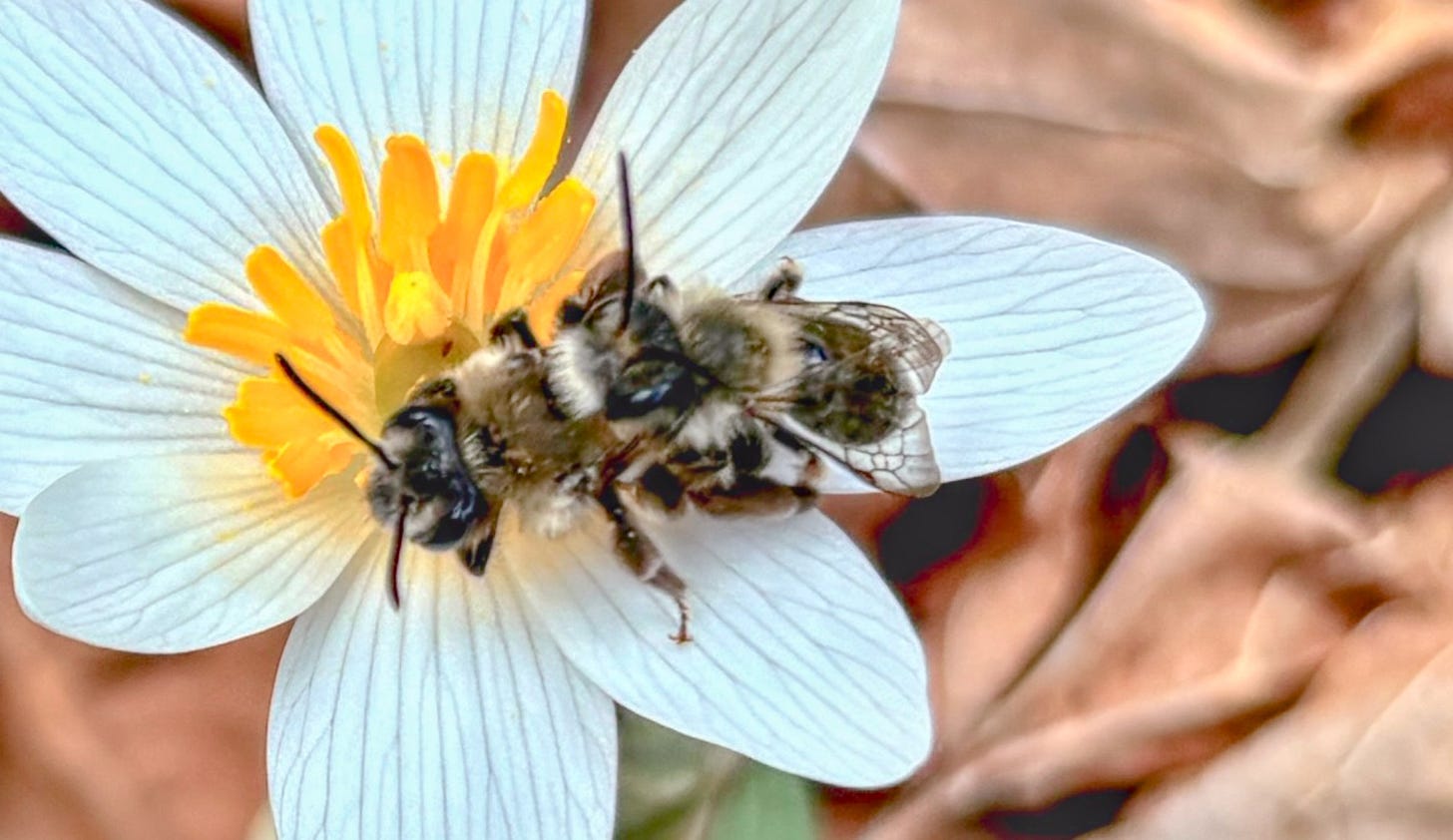Kids, Gardens, Spiders, a Toad ... and a very sad story
There are good things and not so good things in the world this week.
If you don’t feel up to reading all of this newsletter, or are a bit pressed for time, please jump to the end and have a look at the “very sad story,” about some very small birds - Marsh Tits. It tells of a hyper-local event that is illustrative of similar things that are happening all over the world … and if we worry at all about biodiversity and the environment than we need to find means to put an end to such happenings. Thanks.
Suddenly it is the middle of April, temperatures are increasing almost daily though the evenings and nights bring a chill. The brown grasses are taking on a bit of green and suddenly the first shoots of spring are appearing from the ground … some are even bearing flowers. These are the “ephemera”, plants that time their growth, flowering and pollination into that brief period between between the last snows and the leafing out of the forest that casts anything growing low down into deep shade. Historically, this part of the world was a forest environment and open spaces, fields and clearings were few until the “settler culture” arrived and started felling the forests to clear space for agriculture and for our villages and cities. Most of the native plants of Quebec evolved to live their lives alongside trees.
Bright Junior Wildlifers
This has been an interesting week. As you know, if you have been following my writings, I have a particular interest in a style of gardening that creates habitat for wild creatures, particularly insects and birds. Earlier in the week, I was invited by a neighbour who teaches, nine-year-old children in a local school, to come and talk to them about the sort of plants they could grow in a school garden devoted to similar ends and about the species of bees and butterflies they might attract. It was a lot of fun. I don’t have kids and I haven’t had anything to do with nine-year-olds since I was that age (my nephew and niece apart). I was able to show them photographs of native flowers that they could plant and introduce them to the idea of there being more than one species of bee in the world. Butterflies which are always colourful and a lot of fun to see, I think they probably had a good idea about already. They were pretty young kids, but they seemed to be interested in these basic environmental concepts and, who knows, maybe they will go home so enthused by what their teachers are doing at their school they will try to persuade their parents to convert at least part of their gardens into habitat for wild creatures. I got lots of really sensible questions from them and they were so interested that what was supposed to be a half hour session ended up lasting almost twice as long. Kids scare me (sometimes) but these were great. I will be repeating the presentation for another class in a few days.
Anyway, here are some of the not particularly uncommon creatures that have turned up this week in our neighbourhood. Starting with a big spider, because who doesn’t like big spiders …
Plenty happening now, with new critters and plants to marvel over seemingly every day.
Dark Fishing Spider
Dolomedes tenebrosus - adult females can reach 6cm in size but this specimen was more like 1.5cm. While they can bite humans they much prefer to run and hide. Should you be unlucky enough to be bitten (what were you doing to make it think it couldn’t escape?) then the bite is no more severe than a bee or wasp sting.
“There are spiders living comfortably in my house while the wind howls outside. They aren’t bothering anybody. If I were a fly, I’d have second thoughts, but I’m not, so I don’t.”
― Richard Brautigan
There is no reason whatsoever for anyone to be scared of “spiders” in this area. None of them are harmful. In fact, our species are either harmlessly going about their small lives or else are beneficial in that they help to control some of the more irritating insects and other pests.
Fishing Spiders (and Dock Spiders) are the big guys that lurk under logs and in dark crevices. Most of these are species in the genus Dolomedes . Some species can be as much as three inches across. They don’t spin webs to catch prey but stalk their meals and have wide tastes. They will catch and eat all sorts of tasty creatures, including insects, but also tadpoles and small fish such as minnows. Not only that, but they are one of the few invertebrates that eat vertebrates, though they have no interest in eating us. Take a deep breath if they worry you, and just quietly watch these fascinating creatures.
Chipping Sparrows
Spend a lot of time foraging on the ground in the vicinity of trees. Migratory but a fairly early returning Sparrow, and one of the smallest species of Sparrows too. After the breeding season, Chipping Sparrows form flocks of several dozen, foraging together among grasses and at bird feeders. Males sing a characteristic, long, staccato trill of evenly spaced chips.
Frigid Mining Bee (Andrena frigida)
An appropriately named species is likely to be the first of the Andrena species to be active in the spring. Found throughout deciduous forests of the northeast. Distinguished by the long, white hairs all over their bodies. Males are quick to land on objects like bark and even clothing to warm themselves. Will lick tree sap in the absence of flowers. Forage for pollen from early-spring willows but known to nectar from a variety of other plants including maples, plums and cherries. Interestingly, A. frigida nests have not yet been described, but females likely “nest below ground in sandy soils near their Salix host plants” … which is interesting as while we have plenty of Maple and Cherry trees adjacent to where they were seen the nearest willows are some distance away.
Camberwell Beauty (Nymphalis antiopa)
Known on this continent as the Mourning Cloak butterfly. Can live 11 to 12 months, and thus have one of the longest lifespans of any butterfly. The North American name Mourning Cloak is a translation of the old names from several European countries while Camberwell Beauty is exclusively from Britain and the name I have always been familiar with … and originated from the discovery of two individuals at Coldharbour Lane in Camberwell, London in August 1748. Migrants from mainland Europe arrive in Britain most years during summer and autumn, but numbers are usually low. There is no evidence that the species breeds in Britain. Can live 11 to 12 months, and thus have one of the longest lifespans of any butterfly. Adults hibernate during the winter months. Typical locations of overwintering include tree cavities and on the ground underneath loose tree bark - they are one the first butterflies to be seen each spring.
On a sunny, but cool morning one of the outdoor staff, a venerable toad, was snuggled in amongst the base of a golden rod plant where he is assumed to have passed the winter well protected. He was left in peace to get some rays from the sun.
(😉 … Tom Toad made himself known on J’s birthday … not many princesses get visited by a toad on such an auspicious date )
Marsh Tits
I’d like you all to read this short article about the decline and vanishing of a rare, small bird in England. What this tale, a very sad tale, illustrates is something happening to varying degrees all over the world. It is certainly happening here in Quebec. Please click this link (button) to read the story.
The area of ancient woodland that the article focuses on is only a short drive from a village in which I lived for 20+ years, so the story is especially sad for me. Here’s a short extract. The speaker is a government scientist whose work is focussed on species loss:
In the neighbouring territory there was a love story with a pair that were together for eight years. They were never apart. Then, one day, she disappeared. “It brought a lump to my throat,” says Broughton. The male appeared bereft, and didn’t pair up with the available females around him. Two months later he died too.
Broughton says he sometimes finds it hard to conduct science and see this happening on our watch. The wood is full of memories of particular birds, families and nests that are now long gone. “There is an emotional toll. I can’t feel neutral about it, I can’t just treat them as datapoints,” he says. “It’s my own ‘silent spring’.”
Finally …
A directory of people writing about nature themes - if you like this sort of stuff, here is where to find more of it.













We have bush tits here in Oregon but they haven't showed up yet. They are my second most favorite bird and it would break my heart if they were heading to extinction like their cousins.